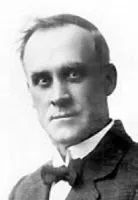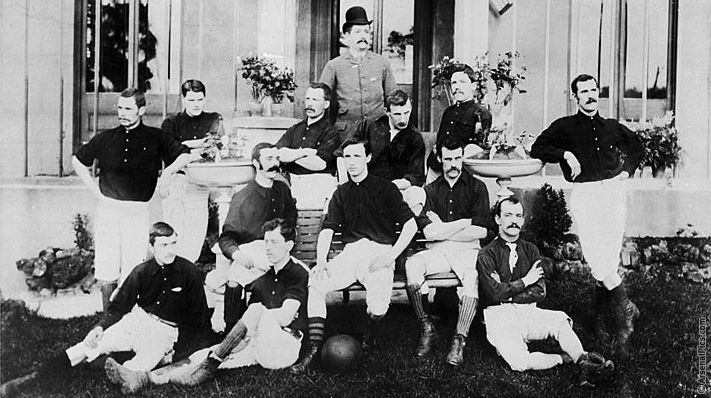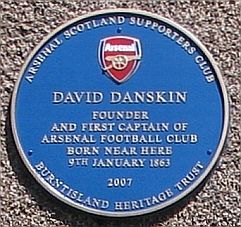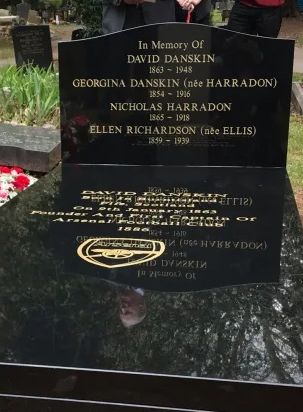David Danskin
- Arsenal founder

If you were asked to name the bigger clubs south of the border, then Arsenal would surely be up there. However, if asked to name players that have played for Arsenal and for Scotland then it may be more of a struggle. Recently, Kieran Tierney (albeit born on the Isle of Man) has, as this is written, reached 41 Scotland caps, and although only 18 of these have been whilst he was at Arsenal, he is now their most capped Scotland player. But before him not only has there been in recent times a lack of players representing Scotland, but there have been no Scottish-born players at Arsenal. In fact, the last Scottish-born player to play for Arsenal before Tierney was Scott Marshall in July 1998.
However, this may in part be explained by the recruitment policy under the long-serving Arsene Wenger - until his arrival, Scottish players were well represented at Arsenal, with almost half of their squads from their foundation until the 1960s being from North of the Border. Probably the most famous player pre-WW2 was Alex James. Capped from 1925 onwards, and a Wembley wizard in 1928 as a Preston North End player, he joined Arsenal in 1929, winning a further 4 caps, and an Arsenal legend in 1930s under Herbert Chapman, when they won 4 titles and 2 FA cups. Then, of course, during WW2, one of the famous Glenbuck crop of players, Bill Shankly appeared for Arsenal from 1942-43.
Furthermore from WW2 onwards Arsenal players with Scotland caps include George Graham, Bob Wilson, Charlie Nicholas and Tommy Docherty, but only Nicholas and Tierney have more than 10 caps whilst playing for Arsenal. And there is also Joe Baker. He made 144 appearances for The Gunners at two goals every three games and won eight caps. But, whilst outwith the game he lived almost all his life in and around Wishaw and spoke broad Scots, because he was born en route from New York to The Well, in Liverpool, and his era was, unlike Wilson’s, pre-1971 his representative honours could only be for England.
But further back still the 1st Arsenal player capped for Scotland was Bobby Templeton in 1905. And although there are a large number of Scottish international players who have played for/coached Arsenal since its foundation in 1886, there are only really a few whose time there is of real significance – one-cap Alex Graham, who was captain for a brief period, played for the club for 12 years from 1912 – he in fact played in Arsenal’s last match at Woolwich before the club went to Highbury in 1913 (and then dropped ‘Woolwich’ from their name).
However, one not on the “internationalist” list is David Danskin. He was never picked to represent Scotland not least because he played outwith the country. From 1883 qualification required both birth and residency and by the time the SFA revoked the latter rule in 1896 it was too late. But why is this even of interest to this article? Well, the relatively small number of players at Arsenal who represented Scotland is even more surprising when it is Scotsman Danskin, who is credited with not just playing for but founding the club.
David Danskin was born in January 1863 in Fife, in Burntisland, named after his father, also David, the family being from the Markinch area nearby. The surname means a citizen of the Polish city, Gdansk– in fact, Danskins are found all along the east coast of Scotland and northern England. And why is this relevant? The family tree on my grandmother’s side goes back to David Danskin’s sister, Christina, David being the brother of my own grandmother’s grandmother.

David at age 18 was an apprentice engineer in Kirkcaldy and in 1885, at the age of 22, he moved from there to what was then Kent, to take up employment at the famous Woolwich Arsenal munitions factory. He worked in the Dial Square gun-finishing workshop, in 1886 making a very nice 35 shillings a week. Moreover, in October of that same year, he was the main instigator in a group subscribing towards purchasing a football, organising a collection among his work colleagues. Indeed he bought the ball and then was instrumental in founding a football club called Dial Square, named after their workshop in the factory.
Although it is unknown where he learned to play football, although Kirkcaldy is likely, he was quoted in a newspaper article in 1931 as wishing to play Association football like he had in Scotland. Moreover, at the initial training sessions, he observed that his colleagues were not aware of the basic rules, rugby being the predominant ball game at the time, and he instructed them how to play his game - he is therefore another Scotch Professor who showed England how to play not just THE game but the passing- and running-game.
Dial Square’s first fixture was played on 11th December 1886 against Eastern Wanderers at Millwall, and, captained by David, victory was theirs, 6-0. Of importance is that after the game in the Royal Oak public house, they renamed the club Royal Arsenal Football Club, which, having turned professional in 1891, again changed name in 1893 to Woolwich Arsenal, as it first joined the League and then became a Limited Company. Subsequently, on moving to north of the Thames to Highbury in 1913, the club was to adjust its name from Woolwich Arsenal to simply Arsenal.
David appeared regularly at first as Arsenal developed, but then slowly faded from the scene, not playing after 1889. And that appears to be the beginning of the end of his association with the original club – although he still had an interest in football. David plus several of the founders and early players were to be pushed out in 1892, founding an amateur team, Royal Ordnance Factories.
Meanwhile Woolwich-life continued. In 1901, great, great uncle David established a cycle company in neighbouring Plumstead, manufacturing and selling bikes under the name Cushie-doo in a nod to his Scottish roots. In 1907, he sold the business and moved to Coventry, taking his football memories and memorabilia with him. There he worked for the Standard Motor Company, prospered for a while, but mobility problems led to retirement. He listened to the FA Cup Final in 1936 from his bed, and when Arsenal won it, they held a dinner in his honour. He was hospitalised in 1942, and remained so until his death in 1948, aged 85. He was buried in a cemetery in London Road in Coventry in an unmarked plot. As for the memorabilia. His house was damaged in a bombing raid in WW2, and when he returned to it, all had been stolen.
And that is where the story would have ended until in stepped Richard Wyatt, a grandson of David through his 2nd marriage. He wanted to find out more about his grandfather, and with the wonders of the internet, this then led to interest from the Arsenal Supporters Club of Scotland. They were instrumental in commemorating the man himself by arranging a Blue Plaque at the approximate site of his Burntisland birthplace. It was unveiled in 2007 and by Bob Wilson.
However, what of his resting place? As mentioned above, David had been laid in an unmarked plot in a cemetery in London Road in Coventry. Although he was a man of significance, and indeed was probably well-known in the community, like many others who died after WW2 in the area, they were buried in unmarked or modest graves. There is nothing sinister to be read into this – in a time of great change and uncertainty, there had to be a focus on rebuilding cities and their infrastructure, which was especially true of war-time Coventry.
Nevertheless, again Richard Wyatt’s interest in the family history had in the early 2000s prompted him to try to enquire more deeply, but as he was living in Canada, access to local records and information was extremely difficult at such a distance. It was only as time progressed that Councils began to digitise their archives and make online research possible with the result that in 2008 a final resting place had been established and by local historians. But even then the task was not complete. Indeed, it took a further a further decade, until 2018, until there was sufficient enough interest to commemorate and mark the site. After a lot of effort from many parties, but driven once more by members of the Arsenal Scotland Supporters Club, a new headstone for the founder of the club was arranged, and in April 2019, his refurbished and rededicated grave was revealed in a moving ceremony attended by David’s descendants, club representatives and Scotland-based Arsenal fans (the headstone being paid for by Arsenal).
Arsenal football club has not forgotten David Danskin’s importance. To celebrate their 125th anniversary in 2011, it arranged for his great-grandchildren to be the team mascots on the fixture closest to the date that he and fourteen other workers from the Royal Arsenal munitions factory formed their new club. And his name is displayed on the exterior of their then new home stadium as one of the 50 most influential players in the club’s history, and in the walkway to the stadium, there is a picture of the man and a quote attributed to him.
The different ways in which David Danskin’s life and achievements are commemorated again demonstrates the power of the family of football fans coming together to ensure that the pioneers should be recognised and remembered. It is great to see a club acknowledge its history and contribute towards its preservation – it is a shame that other clubs and national associations do not show similar interest.
by Ali Firth
with thanks to the following who helped with this article – Richard Wyatt, Iain Campbell Whittle, Burntisland.net and arsenalscotland.com
Back to the SFHG Home page

